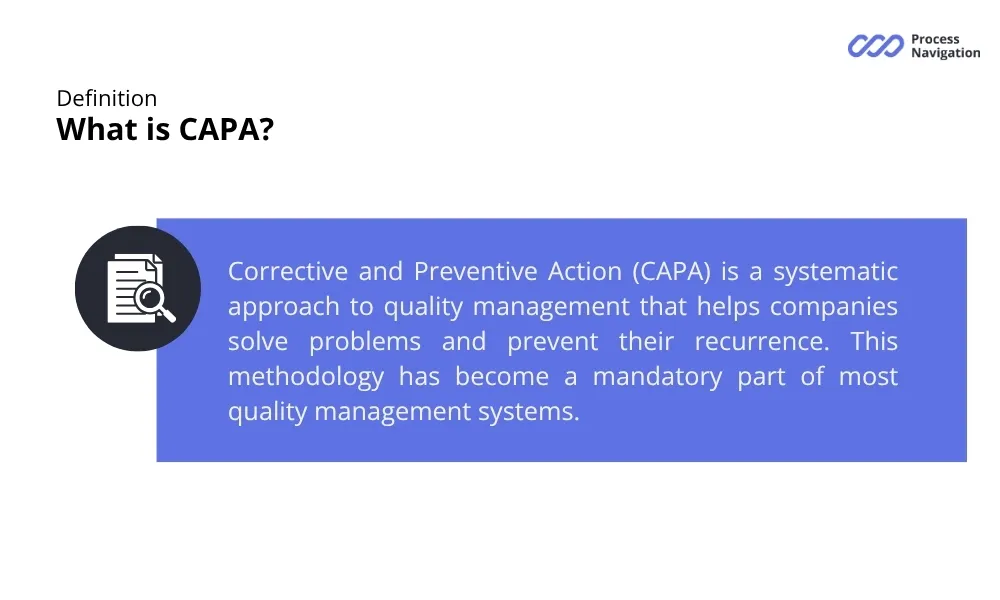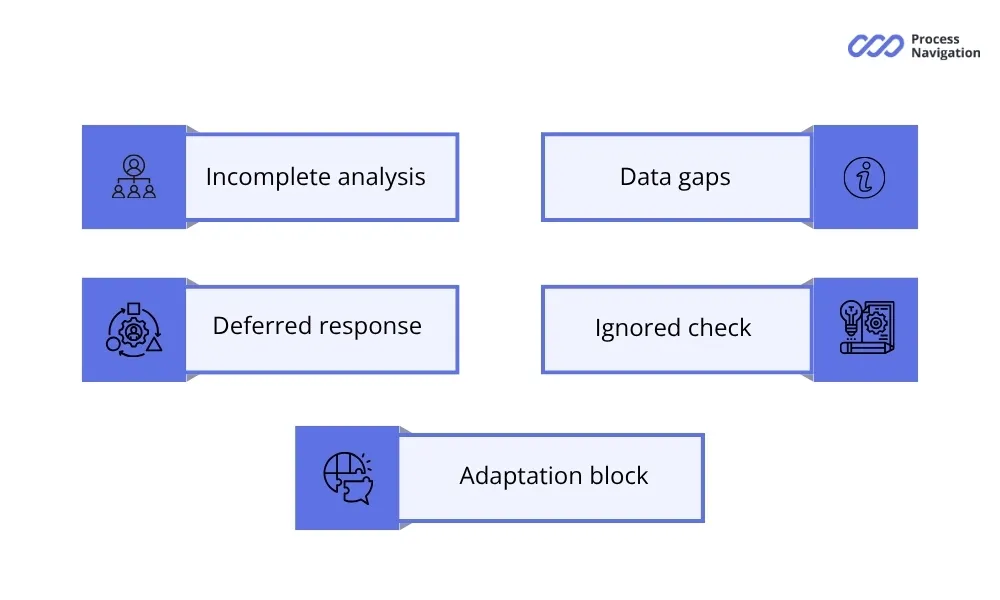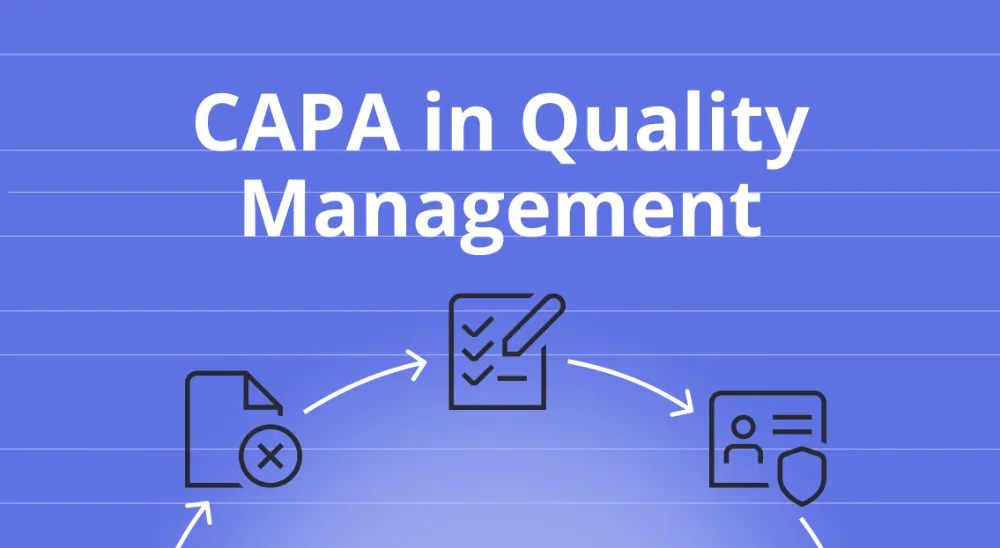There are many problem-solving methods in the world of quality management, but one has become the standard for most companies. It is the CAPA system, a comprehensive approach that not only corrects problems, but also prevents them from recurring.
Corrective and Preventive Action (CAPA) is a fundamental part of quality management systems (QMS) in industries like manufacturing, pharmaceuticals, medical devices, and food production. It is a methodology for identifying, fixing, and preventing defects, nonconformities, and other product and quality problems that can affect product quality, safety, or regulatory compliance.
CAPA is not just about fixing existing issues when they happen; it’s also about being proactive to prevent future problems, continuous improvement and operational excellence.
The CAPA system is a mandatory element of most international quality standards and is critical to maintaining high standards of an organization’s performance. By applying effective CAPA practices, companies can better manage risks and sustain long-term improvements.
What is CAPA
Corrective and Preventive Action (CAPA) is a systematic approach to quality management that helps companies solve problems and prevent their recurrence. This methodology has become a mandatory part of most quality management systems.
What does CAPA stand for? Understanding the essence of CAPA begins with decoding the abbreviation itself:
| Letter | Meaning | Description |
| C | Corrective | Actions to correct identified issues |
| A | Action | Concrete steps and activities |
| P | Preventive | Measures to prevent future problems |
| A | Action | Proactive actions |
Define CAPA in simple terms: it is a process that helps you find the cause of a problem, fix it, and make sure it doesn’t happen again.
Root Cause Analysis: the Basis for Effective CAPA
An important first step in CAPA process is to find the real reason why the problem happened. A thorough investigation allows teams to discover underlying causes of nonconformities instead of only treating the surface.
The quality of the entire CAPA system directly depends on the depth and accuracy of the root cause analysis. Without a proper understanding of the true causes of the problem, any corrective actions will only be a temporary fix for the symptoms. Root cause analysis is a systematic process of identifying the main factors that led to the emergence of a problem. In the context of CAPA, this is a critical step that determines the effectiveness of all subsequent actions.
Root Cause Analysis Methods
Choosing the right analysis method depends on the type of problem, available data and time constraints:
| Method | Application | Advantages | Limitations |
| 5 Why Technique | Simple linear problems | Fast execution Easy to understand Does not require special skills | Superficial analysis of complex problems Subjectivity One way of analysis |
| Ishikawa Diagram | Multifactorial problems | Structured approach Teamwork Visualization of connections | Doesn’t show priorities May be too general |
| FMEA | Process design | Proactive approachQuantitative risk analysis Prioritization | Labor intensive Requires expertise Complex for simple problems |
| Statistical Analysis | Problems with data | Objectivity Identification of trends Numerical evidence | Requires a sufficient amount of dataDoes not always show causalityRequires special skills |
The Difference between Preventive and Corrective Actions
Corrective Actions
Let’s look at the first component of CAPA in detail.
Corrective actions are the reactive part of the system that are triggered after a problem is detected, while the preventive action process focuses on anticipating risks before they occur. Both are essential parts of CAPA and together create an effective system for continuous improvement.
The corrective action process consists of five successive stages, each with its own tasks and tools:
| Stage | Tasks | Tools | Result |
| 1. Identifying the problem | Recording of non-compliance Impact assessment Urgent measures | Deviation documentationNon-conformance handling | The problem has been fixed |
| 2. Analysis of causes | Root cause analysisData collectionHypothesis testing | Ishikawa Diagram5 WhyFMEA | The reason has been found |
| 3. Planning | Corrective action planAssigning responsible personsSetting deadlines | Action PlansPDCA cycle | The plan is ready |
| 4. Implementation | Performing actionsMonitoring progressAdjustments | CAPA tracking systemReports | Actions completed |
| 5. Verification | Effectiveness verification Analysis of results | AuditsMetricsTests | Efficiency confirmed |
Preventive Actions
While corrective actions solve problems that have already arisen, preventive actions work ahead of time. This is a more complex, but also more valuable part of the CAPA system, since preventing problems is always more effective than fixing them.
Preventive Action is a proactive measure to prevent potential problems before they occur. The basis for such actions is the analysis of data, trends and risks.
Effective preventive actions rely on a variety of sources of information:
| Source | Description | Examples |
| Data Analysis | Studying trends and patterns | Defect statistics Customer complaints Downtime |
| Risk assessment process | Assessment of potential risks | Process analysis Supplier evaluation New technologies |
| Compliance audit findings | Audit results | Auditors’ comments Best practices Benchmarking |
| Feedback | Information from interested parties | Employee suggestions Customer reviews Competitor analysis |
CAPA Management

Understanding CAPA processes is only half the battle. It is equally important to organize effective management of these processes. Without a clear structure, implementing CAPAbecomes inconsistent and less impactful.
Who is Responsible for CAPA
The success of the CAPA system directly depends on a clear distribution of roles and responsibilities.
Strong CAPA management involves a CAPA coordinator, process owner, and CAPA team. Each of these roles ensures relevant information is shared, decisions are made quickly, and quality controls are consistently applied.
| Role | Sphere | Responsibilities |
| CAPA coordinator | Overall process management Control of deadlines Reporting to management | Assigning Teams Escalating Issues Closing CAPA |
| Process owner | Analysis of the problem in your areaImplementation of actions Provision of resources | Changing procedures Training staff Budget allocation |
| CAPA team | Root cause analysis Development of solutions Monitoring of results | Access to information Time to work Expert support |
PDCA Сycle in CAPA
The methodological basis of CAPA is the PDCA cycle, an ongoing process that ensures consistency of all corrective and preventive actions.
| PDCA stage | Actions in CAPA | Tools | Duration |
| Plan | Problem Analysis Goal Setting Action Planning | Root cause analysis Risk assessment Plan of actions | 20-30% of the time |
| Do | Performing actions Documentation Communication | CAPA tracking system ReportsEducation | 40-50% of the time |
| Check | Effectiveness verification Results analysisRisk assessment | Audits Feedback | 20-25% of the time |
| Act | Standardization Systemic process improvement CAPA closure | Updating documents Training CAPA closure criteria | 10-15% of the time |
CAPA Tracking System
Effective CAPA management is impossible without modern tools. Instead of outdated Excel sheets, companies now use CAPA software that integrates with QMS. This ensures quality records are updated, deadlines are tracked, and relevant information is easily accessible.
A high-quality CAPA tracking system should provide a full life cycle of problem management:
| Function | Description | Benefits |
| Registration | Recording all CAPAs with unique numbers | Complete transparency Elimination of losses Common database |
| Purpose | Automatic assignment of responsible persons | Clear responsibility Rapid escalation Workload control |
| Monitoring | Track progress in real time | Timely actionsPrevention of delaysAnalytics |
| Reporting | Automatic generation of reports and dashboard | Management control Trend analysisKPI monitoring |
Tired of manual tracking?
With ProcessNavigation, you can automate implementing CAPA, reduce errors, and streamline business operations.
Make your CAPA digitalCAPA System Metrics
To evaluate the effectiveness of the system, it is necessary to monitor key performance indicators:
| Metrics | Formula | Target value | Description |
| Timeliness | (Closed on time / Total) × 100% | ≥ 85% | Planning efficiency |
| Closing time | Average time from opening to closing | ≤ 45 days | Speed of problem solving |
| Efficiency | (No repetition / Total) × 100% | ≥ 95% | Quality of decisions |
| Load | Average number of open CAPAs per person | ≤ 5 | Resource allocation |
Efficiency testing should be carried out in several stages using various methods:
| Method | Application | Verification deadlines | Success criteria |
| Immediate check | Control of execution of actions | 1-2 weeks | Actions completed in full |
| Short-term assessment | Primary efficiency | 1-3 months | The problem does not recur |
| Long-term monitoring | Sustainability of results | 6-12 months | Stable performance |
| System analysis | Impact on general processes | Annually | Improving overall metrics |
CAPA Closure Criteria
CAPA closure should only occur after all established criteria have been met:
| Criteria | Requirement |
| Performing actions | All planned measures have been implemented |
| Efficiency | The problem has been solved and will not recur. |
| Documentation | All changes have been made to the documents. |
| Approval | Formal consent of the management |
CAPA in Quality Management System
Once the basic concept is understood, it becomes clear how CAPA fits into the overall quality management system of the company. The system does not operate in isolation — it is the central element that links the various improvement processes.
CAPA quality management is the basis for improving all processes in the company. The system operates within the quality management system (QMS) and ensures compliance with standards.
CAPA is a key to quality management:
- Product Quality: By finding and fixing defects CAPA ensures products meet or exceed quality standards, customers are happier and fewer returns or complaints. Using statistical methods to detect recurring quality issues is vital to maintain high product standards.
- Regulatory Compliance: Industries like pharmaceuticals and medical devices are heavily regulated. CAPA is a regulatory requirement under standards like FDA 21 CFR Part 820, ISO 9001 and GMP. Non compliance can result in fines, recalls or even shutdowns.
- Cost Savings: Addressing issues early in the process reduces the likelihood of recalls, rework or liability claims. CAPA helps organizations save money by preventing problems before they escalate.
- Customer Satisfaction: Fewer defects and recalls mean better customer experience. A robust CAPA system builds trust, loyalty and the brand.
- Operational Efficiency: Streamlining the CAPA process improves workflow, reduces downtime and ensures resources are used effectively.
- Risk Management: CAPA helps organizations identify and mitigate risks, so production isn’t halted and consumers aren’t harmed.
CAPA is a part of many quality management standards:
- ISO 9001: Requires CAPA for continuous improvement. A well structured quality system plays a key role in managing CAPA to ensure product quality and compliance.
- FDA 21 CFR Part 820: Calls out CAPA for medical device manufacturers.
- GMP (Good Manufacturing Practice): Requires CAPA compliance for pharmaceuticals and food production.
- IATF 16949: Applies CAPA principles for quality assurance in the automotive industry.
- ISO 13485: Sets CAPA requirements for medical devices.
- HACCP (Hazard Analysis and Critical Control Points): Includes CAPA in food safety management.
ISO 9001 Compliance and CAPA
For most companies, CAPA is not just a best practice, but a mandatory requirement of international quality standards. The ISO 9001 standard clearly defines the requirements for a corrective action system, and failure to comply with these requirements can lead to loss of certification.
The ISO 9001 standard requires maintaining certain documentation to confirm the effectiveness of the CAPA:
| Document | Content | Status | Storage |
| CAPA procedure | Description of process and responsibility | Required | Constantly |
| CAPA Records | All data on specific cases | Required | Minimum 3 years |
| Reports | Analysis of system efficiency | Recommended | As needed |
| Training materials | Instructions and Guides | Recommended | Current version |
Want a faster way to manage CAPA?
ProcessNavigation gives you centralized CAPA management, ensuring smooth workflows and accountability.
Try it nowCAPA Process: Step-by-step Guide
Creating an effective CAPA is a complex project that requires a systematic approach. Many companies fail precisely because of chaotic implementation without a clear plan. Let’s consider a step-by-step approach to implementation.
The CAPA process is a systematic way to solve and prevent problems. Here’s how it works:
| Stage | What to do |
| Problem definition | Clearly define the problem or nonconformity. Problems can come from customer complaints, internal audits or process deviations. |
| Root cause analysis | Use tools like 5 Whys Method, Fishbone Diagram (Ishikawa) or Failure Mode and Effects Analysis (FMEA) to find the root cause of the problem. Fault tree analysis can also be used as a deductive method to identify potential combinations of failures – including hardware, software and human errors – that may lead to undesirable outcomes, referred to as top events, within a system. |
| CAPA plan | Create a CAPA plan that outlines the steps to fix the problem, assigns tasks, sets deadlines and identifies resources. |
| Corrective Action | Implement the corrective actions which can be design changes, process improvements or staff training. Track these actions to ensure they solve the problem. |
| Preventive Action | Put in place preventive measures to prevent future occurrences. This can be changes to standard operating procedures (SOPs), supplier controls or employee training programs. |
| Monitor and Verify | Verify the effectiveness of the corrective and preventive actions through audits, testing and continuous monitoring. If the problem persists more adjustments might be needed. Process controls are key to evaluating the actions taken in the CAPA process including monitoring outcomes and looking for opportunities to improve. |
| Documentation and Reporting | Document all CAPA activities for regulatory compliance and internal analysis. Quality control checks and updated protocols are necessary to identify problems and prevent future non-conformities. This includes problem description, root cause findings, actions taken and verification results. |
CAPA in Action
Industries must often investigate product failures or complaints. For example, in pharmaceuticals, regulated industries require CAPA to avoid a product recall and meet the expectations of regulatory bodies. By applying corrective or preventive actions early, companies minimize systemic issues that disrupt production and customer trust.
- Example 1: Pharmaceuticals
A pharmaceutical company had recurring contamination on the production line. Through CAPA the root cause was identified as inadequate sanitization protocols. Corrective actions were to revise cleaning procedures and train staff. Preventive actions were to implement automated cleaning validation to ensure sanitization was consistent.
- Example 2: Medical Devices
A medical device company had frequent product failures due to faulty components. Root cause analysis found inconsistent supplier quality was the issue. Corrective actions were to revise supplier qualification procedures and improve incoming material inspections. Preventive actions were to conduct more frequent supplier audits to maintain quality standards.
- Example 3: Food Production
A food company had high rejection rates due to packaging defects. CAPA found temperature fluctuations in the production environment were the root cause. Corrective actions were to upgrade climate control systems. Preventive actions were to monitor and maintain these systems to prevent future issues.
CAPA and Continuous Improvement
One of the main goals of any CAPA system is not just to solve current problems, but also to create a culture of continuous improvement in the organization. Continuous improvement becomes a natural result of a properly organized system of corrective and preventive actions.
Continuous improvement in the context of CAPA means a systematic approach to improving the efficiency of processes through data analysis, identifying opportunities for improvement and implementing changes. These are not one-off projects, but ongoing activities built into the DNA of the organization.
CAPA Challenges

Even with an understanding of the theory, many companies make common mistakes when implementing and managing CAPA. Knowing these mistakes will help you avoid disappointment and improve the efficiency of the system.
- Poor Root Cause Analysis: Bad investigations lead to recurring problems and undermine CAPA. Dealing with these issues involves not only documentation and communication but also validation of actions taken to prevent recurrence and minimize risks.
- Lack of Documentation: No records means regulatory penalties and inefficiencies. Implementing corrective actions is key in this case as it involves investigating nonconformities, identifying root causes and taking necessary steps to rectify and prevent issues.
- Delayed CAPA: Slow processes reduce effectiveness and increase risk.
- No Follow-Up: Not verifying CAPA actions weakens impact.
- Resistance to Change: Employees resist CAPA driven changes.
Best Practices for CAPA
To get the most out of CAPA consider:
- Data-Driven: Use statistical tools and data analysis to find trends and root causes. Quality processes are key to building robust CAPA systems and compliance.
- Employee Training: Train staff on CAPA procedures, quality standards and regulatory requirements.
- Automate CAPA: Use quality management software (QMS) to track, document and report CAPA activities. CAPA tools, including software and templates, help streamline tasks like documentation, root cause analysis and tracking of actions taken.
- Regular Reviews: Review regularly to ensure CAPA processes are working and aligned to business objectives.
- CAPA Review Board: Have a dedicated team to oversee CAPA and hold people accountable.
- Foster a Quality Culture: Encourage a culture where employees report and identify issues for continuous improvement.
Technology has made CAPA a lot more effective. Quality management software (QMS) can automate many aspects of CAPA from tracking issues and documenting actions to generating reports and analyzing data. These tools not only speed up the CAPA process but also give you valuable insights to drive continuous improvement.
For companies looking to streamline their CAPA workflows, ProcessNavigation provides a modern solution. The platform simplifies documentation, automates reminders, and ensures full visibility of corrective and preventive actions across all departments. This helps organizations avoid delays, improve compliance, and focus on continuous improvement.
Modern technologies significantly increase the efficiency of CAPA processes:
| Tool | Functional | ROI |
| Automated CAPA system | Workflow, reminders, reports | Saving 30-40% of time |
| Mobile apps | Access to CAPA at any time | Increase reaction speed by 50% |
| Integration with ERP | Automatic data collection | Reduce errors by 60% |
FAQ
CAPA meaning includes both reactive and proactive components, which distinguishes it from other approaches. Six Sigma focuses on statistical process control, Kaizen on continuous small improvements, Lean on eliminating waste. CAPA integrates all these approaches into a single system: it uses statistical tools for root cause analysis, applies continuous improvement through preventive actions, eliminates waste through process optimization. The key difference is mandatory effectiveness verification and regulatory compliance.
The length of the CAPA process depends on the complexity of the problem, but typical timeframes are: – Simple problems: 30-60 days – Medium complexity: 60-120 days – Complex systemic problems: 120-180 days The key is to set realistic timeframes and monitor progress regularly.
CAPA management requires tracking four key metrics through a CAPA tracking system: timeliness of closure (target value ≥85% on time), average time from opening to closing (≤45 days in most cases), effectiveness of solutions (≥95% without repeating similar problems), workload on staff (≤5 opened CAPA per employee). It is also important to analyze the quality of root cause analysis and systemic process improvement.
Data-driven CAPA at your fingertips
Get insights, streamline workflows, and keep quality records always up to date.
Book a demo-
 CAPA: Corrective and Preventive Action in Quality Management
CAPA: Corrective and Preventive Action in Quality ManagementThere are many problem-solving methods in the world of quality management, but one has become…
Technology • October 27, 2025
-
 How Effective Digital Work Instructions Change Manufacturing
How Effective Digital Work Instructions Change ManufacturingModern manufacturing is undergoing radical changes associated with the transition from traditional paper-based processes to…
Technology • October 27, 2025
-
 Manufacturing Success with SOPs and Standard Work Instructions
Manufacturing Success with SOPs and Standard Work InstructionsEvery day, workers perform hundreds of operations in factories and plants. The safety of people,…
Technology • October 27, 2025